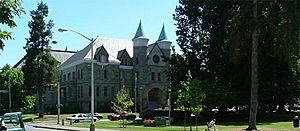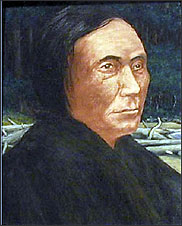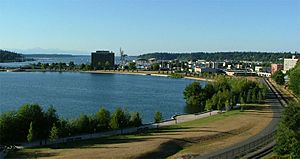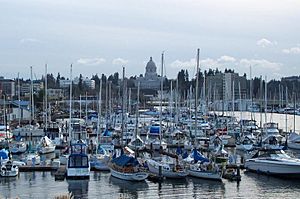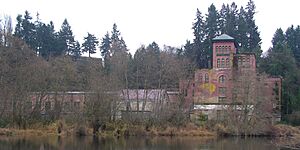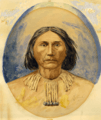History of Olympia, Washington facts for kids
The history of Olympia, Washington is a story of many changes. It started with Native American tribes living there for thousands of years. Later, explorers from Europe arrived, and then settlers built the town in the 1840s. Olympia became the capital of Washington. Over time, it grew into a center for arts, culture, and even a college.
Contents
Early History of Olympia
Olympia is located at the very end of Puget Sound on Budd Inlet. For thousands of years, this area was home to people who spoke the Lushootseed language. They found lots of food here, like shellfish in the tideflats and many salmon in the streams.
Many different tribes shared these resources. These included the Squaxin, Nisqually, Puyallup, Chehalis, Suquamish, and Duwamish tribes. Early settlers said that the Native Americans called the area "Cheet Woot" or "Schictwoot." This name meant "the cold place of the bear."
First European Visitors
The first time Europeans visited this area was in 1792. Peter Puget and his crew from the British Vancouver Expedition explored and mapped the site.
In 1833, the Hudson's Bay Company set up Fort Nisqually. This was a trading post near what is now DuPont, Washington. As the fur trade slowed down, the company started farms. In 1841, the United States Exploring Expedition led by Lt. Charles Wilkes explored Puget Sound. They camped near Fort Nisqually and named Budd Inlet after one of their members, Thomas A. Budd.
How Olympia Was Settled
The first known European to live where Olympia is now was Thomas K. Otchin. He was an English employee of the Hudson's Bay Company. He claimed land in 1841 but left by 1842.
American settlers started coming to the area in the 1840s. They were interested in the water power from Tumwater Falls. They built a settlement called "New Market," which is now Tumwater. This was the first American town on Puget Sound. The site was also the northern end of the "Cowlitz Portage." This was an overland trail between the Cowlitz River and Puget Sound. Since water travel was easiest back then, Olympia's location made it a key spot for trade.
In 1846, Edmund Sylvester and Levi Lathrop Smith claimed the land that is now downtown Olympia. Smith built a cabin and a garden. In 1848, Smith was elected to the Oregon Provisional Legislature. Sadly, he died that same year while canoeing. This left Sylvester as the only owner of the land. Early names for the settlement were "Smithfield" and "Smithter" to honor Levi Smith. In 1853, the town was named Olympia. This name was suggested by Isaac N. Ebey because of the beautiful view of the Olympic Mountains.
In 1848, Catholic missionaries set up a mission and school near the future town site. It was called Mission St. Joseph of Newmarket. They did this to help convert Native Americans to Catholicism.
Growth in the Mid-1800s
In 1851, the U.S. Congress made Olympia the official customs port for Puget Sound. This meant all ships had to stop there first. In 1854, the customs house moved to Port Townsend. This was closer to the entrance of Puget Sound to watch ships better. In 1852, Olympia became the main town, or county seat, of Thurston County.
Around 1853, Olympia had about 100 people. It had three stores, a hotel, a stable, a saloon, and a weekly newspaper called The Columbian.
By the early 1850s, American settlers wanted the area north of the Columbia River to be separate from Oregon Territory. This led Congress to create Washington Territory. Isaac I. Stevens became its first governor. When he arrived in 1853, Stevens chose Olympia as the capital of the new territory. The first territorial legislature met in early 1854. Daniel Bigelow represented Thurston County in these early meetings. His family home, the Bigelow House Museum, is Olympia's oldest surviving home.
The city grew steadily until 1873. That year, the Northern Pacific Railroad built a line to Puget Sound but skipped Olympia. They chose Tacoma as their main stop on the west coast. Olympia residents were worried. They decided to build their own rail connection to the main line at Tenino. Citizens formed a company to raise money. Rebecca G. Howard, a black businesswoman, helped by donating 80 acres of land. Volunteers and Chinese workers built a narrow gauge line by 1878. This small railroad was Olympia's only connection until the Northern Pacific built a spur to Olympia in 1891.
After Washington became a state in 1889, Olympia remained its capital. Construction of the current Washington State Capitol began in 1912. The large Legislative Building was finished in 1928. Its dome is the fourth largest free-standing stone dome in the world.
Besides being the state capital, Olympia was a typical Pacific Northwest town. Early on, its economy relied on logging and oystering. Later, sawmills, fruit canning, and other factories became important. Olympia also served as a port for shipping things like sandstone, coal, and farm products.
From 1890 to 1950
Olympia is often known for the Olympia Brewing Company. This company brewed Olympia Beer from 1896 to 2003. The brewery was actually in Tumwater. It started making beer in 1896. It stopped during Prohibition, a time when alcohol was illegal. After Prohibition ended, a new brewery was built. This brewery was later bought by SABMiller and closed in 2003.
After World War I, Scandinavian immigrants started two cooperative plywood mills. During World War I and World War II, more workers came to Olympia. They were drawn by wartime jobs like shipbuilding.
Earthquakes sometimes affect the Olympia area. The 1949 earthquake badly damaged many old downtown buildings. Some were torn down. Others were updated with new fronts. This is why much of downtown Olympia looks like it was built in the mid-1900s. Olympia also had damage from the 1965 Puget Sound and 2001 Nisqually earthquakes. Olympia was the closest major city to where the 2001 earthquake happened.
Olympia Today (1960s-Present)
Since the 1960s, Olympia has lost many of its old waterfront industries. These included lumber mills, shipbuilding, and power pole factories. The shipping port is still there, but the waterfront area has changed. It has become more developed and popular since the 1980s.
In 1967, the state approved the creation of The Evergreen State College near Olympia. This happened mostly because of Governor Daniel J. Evans. He later became the college's president.
Because of the college, Olympia has become a place for artists and musicians. Many have been important in punk, post-punk, anti-folk, and lo-fi music. In 2003, Outside Magazine called Olympia one of the best college towns. They liked its lively downtown and outdoor activities.
Olympia is also a center for social justice and environmental activism. Rachel Corrie, a well-known activist, was from Olympia. The city has also been a place for protests against the Iraq War.
Olympia hosts the state's largest annual Earth Day celebration, called the Procession of the Species. This is a community arts festival and parade. The Olympia farmer's market is also popular. It is the second largest in Washington State. The local Olympia Food Co-op is also well-liked.
Olympia has its own independent media. These include KAOS FM 89.3, Free Radio Olympia 98.5 FM, and Olyblog. There are also local publications like Works in Progress. These keep residents informed about local news.
Images for kids


